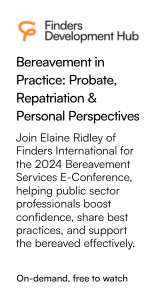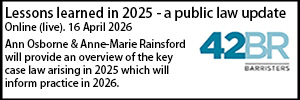Ensuring compliance with Court of Protection orders
- Details
How far can the Court of Protection go to ensure its orders are complied with? Alex Ruck Keene KC (Hon) examines a recent ruling.
In LB Hackney v A, B and C [2024] EWCOP 33, John McKendrick KC has answered a question which, as he noted, had curiously not been answered since the MCA 2005 came into force – namely how far-reaching a set of injunctive measures it can grant to compel compliance with its orders.
The issue before the court was as to the steps that could be taken to compel P’s mother to return him to the placement where the court had determined it to be in his best interests to live. An order had been made by a Tier 1 judge requiring P’s mother and her partner to return P to the placement; a copy of this order had been given to her, and she had ripped it up. Further orders were made, backed by penal notices, but the local authority could not serve them because they did not know where the mother and partner (and P) were. Matters were then escalated to Tier 3, with the local authority seeking a collection order, and an order against two telephone companies for the disclosure of information to assist in identifying where P’s mother was. The urgent application came on on the basis of orders being sought under the MCA 2005; an undertaking was also made that an application would be issued under the inherent jurisdiction.
John McKendrick KC noted the seriousness of proceeding without notice to the mother and partner, but that this was a consequence of them having failed to engage with the proceedings (paragraph 10). He then noted that he had been referred to the pre-MCA 2005 decision of HM and PM and KH [2010] EWHC 870 Fam, in which (sitting in the inherent jurisdiction), Munby LJ had examined in characteristic detail the jurisdictional basis of the High Court’s powers to grant injunctions under the inherent jurisdiction, and had made a whole raft of orders directed to locate and bring about the safe return of the subject of the proceedings.
Whether the Court of Protection had such wide-ranging powers was, John McKendrick KC, not the subject of a reported judgment. He noted, however, that the Court of Appeal had made clear in Re G [2022] EWCA Civ 1312 that the Court of Protection had the power to make injunctions under s.16(5) MCA 2005 where it was just and convenient to enforce a best interests decision. He also referred to the subsequent judgment of Senior Judge Hilder in HM and PM and KH [2010] EWHC 870 Fam, which also considered the same issue.
John McKendrick KC noted that “if there is a statutory scheme, then the court must follow that scheme as Parliament set down and resort to the Inherent Jurisdiction only in those limited circumstances where a true statutory gap and where it is necessary to do so. I paraphrase” (paragraph 23).
John McKendrick KC found that, in the very concerning circumstances of the case, and the “very highest level of concern” (paragraph 24) he had for P, it was “necessary, proportionate, and overwhelmingly just and convenient” (paragraph 26) to make a collection order to locate and safeguard him by returning him to his home. He considered that it was necessary to make such an order enforcing the Tipstaff and police to enter into third party properties for those purposes, and that he had the jurisdiction to do so under s.16(5) MCA 2005 (see paragraph 27).
John McKendrick KC noted, however, that there was a potential debate about whether a Tier 1 or Tier 2 judge could have made this order by importing the High Court’s inherent jurisdiction via s.47 MCA 2005. And, to put the jurisdictional basis of his order beyond doubt, he also made the same order sitting as a High Court judge exercising the inherent jurisdiction (see paragraph 28).
John McKendrick KC also found that he had the ability to make the orders sought against the telephone companies as “orders made in connection with the Court of Protection’s jurisdiction and the […] earlier best interests order in respect of A’s residence” (paragraph 29).
In a postscript, John McKendrick KC recorded that A was returned to the placement some days later, although tantalisingly not by whom.
Comment
As John McKendrick KC made clear, the judgment was one delivered at speed and ex tempore (i.e. on the spot). It is entirely understandable, therefore, that he deployed the belt and braces approach of both making the orders sought as a Court of Protection judge exercising powers under s.16(5) MCA 2005 (and, following Re G, by importing the High Court’s powers to make injunctions under s.47) and sitting as a High Court judge exercising his powers under the High Court’s inherent jurisdiction.
It is, however, to be mildly regretted that he did not roll up his judicial sleeves and determine whether a Tier 1 or Tier 2 judge themselves could have made the orders. It is undoubtedly the case – I would suggest – that the Court of Protection cannot simply import the High Court’s inherent jurisdiction to make substantive orders about those who do not lack capacity applying the test in the MCA 2005 [1]. However, that jurisdiction is distinct to the inherent common law power of the High Court to control its own processes and enforce compliance with its decisions (see e.g. Griffin v Griffin [2000] EWCA Civ 119 at paragraph 21). If the Court of Protection cannot import the High Court’s own powers to do “hefty” stuff to enforce its best interests determinations it means that Tier 1 judges (who hear the vast majority of cases) are hamstrung in their ability to enforce their rulings. Every time their orders are frustrated in the way that happened here, they will need to refer the case to a judge with the power to sit as a High Court judge, hearing a (fresh) application issued under the inherent jurisdiction.
For what it is worth, I am of the clear view that Court of Protection judges can use the magic sparkle dust of s.47 MCA 2005 (allied, I would suggest, to s.16(5) to make clear why) to import the extensive suite of powers available to the High Court to ensure that their orders are given effect to. That does not mean that they should have ready recourse to it, nor that there is not good reason to transfer up particularly high octane cases to be heard by Tier 3 judges, but those are both separate matters.
Alex Ruck Keene KC (Hon) is a barrister at 39 Essex Chambers. This article first appeared on his Mental Capacity Law and Policy blog.
[1] As to which see our guidance note.













































